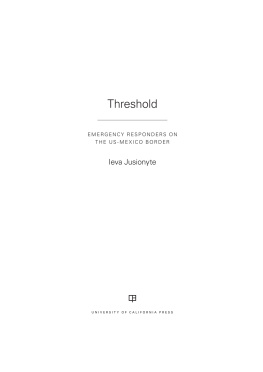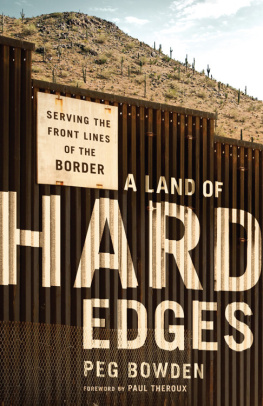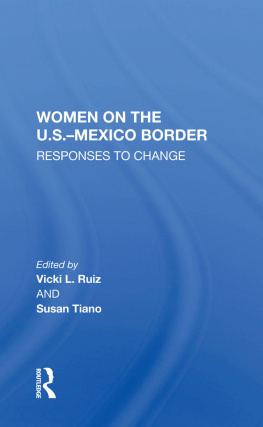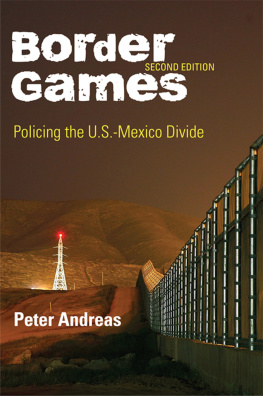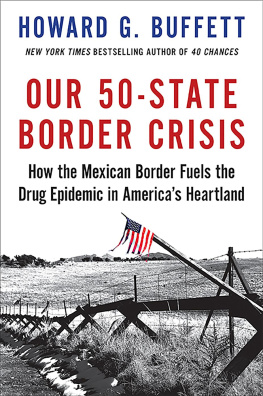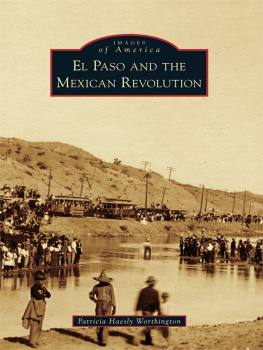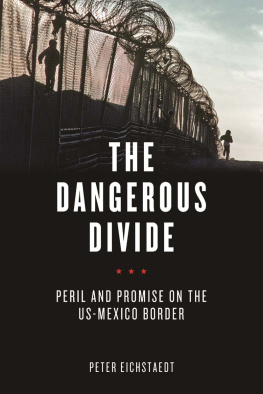University of California Press, one of the most distinguished university presses in the United States, enriches lives around the world by advancing scholarship in the humanities, social sciences, and natural sciences. Its activities are supported by the UC Press Foundation and by philanthropic contributions from individuals and institutions. For more information, visit www.ucpress.edu.
Title: Threshold : emergency responders on the US -Mexico border / Ieva Jusionyte.
Description: Oakland, California : University of California Press, [2018] | Includes bibliographical references and index. |
Identifiers: LCCN 2018008950 (print) | LCCN 2018014229 (ebook) | ISBN 9780520969643 (epub and e PDF ) | ISBN 9780520297173 (cloth : alk. paper) | ISBN 9780520297180 (pbk. : alk. paper)
Subjects: LCSH : Emergency medical servicesMexican-American Border Region. Rescue workMexican-American Border Region. | Mexican-American Border RegionEmigration and immigrationSocial aspects.
Classification: LCC RA 645.7. M 58 (ebook) | LCC RA 645.7. M 58 J 87 2018 (print) | DDC 362.180972/1dc23
To Bojo, Alex, Capt. Lopez, and all fellow firefighters who save lives on both sides of the line
Introduction
The US-Mexican border es una herida abierta where the Third World grates against the First and bleeds. And before a scab forms it hemorrhages again, the lifeblood of two worlds merging to form a third countrya border culture.
GLORIA ANZALDA,
Borderlands/La Frontera
DEAD END
Vmonos? Alex was waiting for me in the truck, ready to start the engine.
The fire was in Mexico. We were a few miles north of the border, in the United States, wearing navy blue T-shirts with logos of the Nogales Suburban Fire District. Concerned that the blaze could jump the line into our jurisdiction, the chief instructed us to go and check it out.
We didnt need to hurry. Heading south, we passed an area known as the Buena Vista Ranch: a handful of houses cradled in the desert, its pale skin barely covered by a stubble of mesquite trees. I could see why back in the day John Wayne made movies here: the scenery was an ideal stage for a Hollywood Western. Several hydrants, their red paint beginning to fade, pointed to another story, one about plans to develop the area. But the ranch happened to be on a route of intense drug and human trafficking. Locals say that fear of violence associated with illicit trade scared potential homebuyers away, squelching their dreams of building a community. We passed a yellow Dead End sign perforated by bullets (target practice, Alex reassured me), unhitched a gate with a barely legible sign warning no trespassing, and after a few turns found ourselves on a dirt road running parallel to the border wall.
From afar, the wall is but a squiggly dark line following the contour of the hilly landscape; close up, it resembles the spiky spine of a stegosaurus, low curves giving shape to menace and fear. Stretching as far as the eye could see, to the east and to the west, the road next to the wall served as the US Border Patrol highway: federal agents, in search of unauthorized border crossers, steer a fleet of white trucks with green stripes up and down these slopes, expecting spectacular, newsworthy captures of marijuana, cocaine, or methamphetamine loads, but more often encountering tired migrants with tattered clothes and blistered feet.
The fire department could use the road too, at least in emergency situations. Driving along the wall, we continued scanning the sky for smoke. Only a few days had passed since I chased fires with the crew of Mexican firefightersthe bomberosin Nogales, Sonora. It was May, more than a month until the summer rains would arrive, and fires were so abundant that the bomberos might go from one call to the next without taking a break. On this side, in Arizona, fires were less frequent, but once they started, they could expand rapidly, fiercely devouring the dry vegetation and often requiring the US Forest Service to bring in helicopters and elite firefighter crewsthe hotshotsto battle them for days or even weeks in remote canyons. The average temperature in Arizona has increased by over 2F since the 1970s, making wildland fires in the region both bigger and more severe. Down by the wall looking for smoke that morning, Alex and I didnt yet know that later in the afternoon La Sierra Fire would start in Sonora and cross the border about 17 miles west of us, on the opposite side of Nogales, burning thousands of acres and requiring joint efforts of Mexican and American firefighters to contain it. Binational cooperation in such situations was commonemergency managers and frontline responders recognized that the border did not stop fire. Nor, for that matter, did it halt flash floods, toxic fumes, or any other natural or manmade disaster.
We reached a place where the metal wall abruptly ends and gives way to several strings of barbed wire and a low-lying steel beam construction, known as a Normandy barrier. Even though it may not be obvious during the dry season, when all you see are lush green trees and occasional puddles of water, this is the bed of the Santa Cruz River, which crosses the border perpendicularly, running south to north. It is an important path for migratory wildlifedeer, javelina, mountain lions, ocelots, and the only known wild jaguar in the United States, El Jefe, who lives in the Santa Rita Mountains. The engineers didnt build a wall here since a solid barrier would threaten endangered species and cause damaging floods. Unauthorized pedestrian traffic, involving migrants and drug mules, know about this gap, too. Dry arroyos are convenient paths across the undulating desert terrain: capillaries circulating life without regard to who is legally entitled to it.
We still didnt see any smoke. Nor, surprisingly, did we see any Border Patrol.
Alex was not fond of the Border Patrol. Though he meets them regularly on the job, when he goes through the checkpoint on I-19 they often look at him with suspicion. These guys, they come to Nogales from somewhere over there, say Montanathe Holy See of white peopleand at the checkpoint they see Hispanic people, Mexican people, driving up and down all day long. Alex has been pulled over regardless of whether he drove his personal vehicle with firefighter union decals and his bunker gear thrown on the backseat or an official city truck with government license plates. They would still ask him: Is this your vehicle? Do you have anybody in the trunk? Short and stocky, with black hair and a thick mustache, he knows he looks like a stereotypical Mexican. He orders chilaquiles with a side of tortillas, making young Sonoran waitresses smile. He is also stubborn. I just laugh. I never answer, he says, referring to the questions by federal agents. I believe him, for I saw how it played out at the station, where Alexs blunt remarks were habitually taken as offenses. He had no intention to change. One time, after a joint exercise held in the tunnels under Nogales, he even had the guts to tell the Border Patrol that had it been a real emergency, he would not have stayed to rescue an injured federal agent; he would have grabbed his partner and they would have run for their lives. Im an honest asshole, he admits. The agents at the checkpoint must sense his defiance: they send Alex into secondary inspection, again and again. A price hes willing to pay for feeling righteous.

